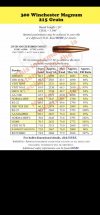vancewalker007
Well-Known Member
- Joined
- Mar 30, 2013
- Messages
- 984
If you have not shot at least a velocity ladder, you will not know if your on a boundary of 2 velocity nodes. You can get big velocity jumps if you are which can cause vertical issues. For example if you measured velocity in a ladder it you will see a pattern like the following (contrived example). Your see small velocity variations then you'll move up a little more and the velocity will jump. You need to stay away from those jump points unless you like pulling you hair out.Hi All,
So I have a Bergara Premier Highlander in .300 Win Mag that I am working on some hand loads for. I am using Berger 215's, H1000, Norma Brass, CCI 250's, and Redding Type-S Bushing Dies. Gun will be primarily used for elk hunting out west.
I followed Berger's starting point of 70.5 grains of H1000, and shot .015, .020, and .030 off the lands.
See the first imagine below - the .030 off the lands shot the best (by far). (Image without a circle)
So, 70.5gr is pretty light for H1000 in a .300 WM, and decided to bump the powder charge up to 74gr (imagine with the red circle). This caused the groups to open up. This had zero pressure signs.
Question is, from here, do I bump up to say 75 gr and keep going until I see pressure - then tweak the seating depth again? Was hoping that the powder increase would not open the groups that much. I am new to this precision reloading.
I do this test when first developing a new load. I'll pick a safe CBTO like 40 off, then load a single round per charge weight starting 10 shots below max and stepping up a little at a time to book max. For bigger cases you can use larger steps, I like .2 gr because is gives me very good resolution on the node points. This is a velocity test, not an accuracy test so I don't usually even shoot it on paper. There is a method that you shoot similar ladder loads on paper at say 300 yards that gives around the same information, its just harder than using a chrono.
Either way you will safely find you rifle's pressure max and your pressure/velocity nodes to load in. So using the example below 74.4gr will give very similar results to 74.5gr or 74.6gr. So if your a little off on you measuring or if you run in super cold or hot weather your load has some flexibility. Once I pick a powder load then I use seating depth to fine tune groups. I seem to use up less components doing it this way. If you are shifting powder weights and seating depth at the same time its hard to really track what is causing changes and you use a lot of components.
73.6gr - 2905fps
73.8gr - 2900fps
74.0gr - 2950fps <<-- jump point
74.2gr - 2970fps
74.4gr - 2980fps
74.6gr - 2975fps
BTW - These velocity nodes will shift a little in speed once your barrel hits its speedup. So a speedup will usually not change the load jump points the velocity will just be a little higher. So 74 will still be a jump point but the velocity might be say 30fps faster.

